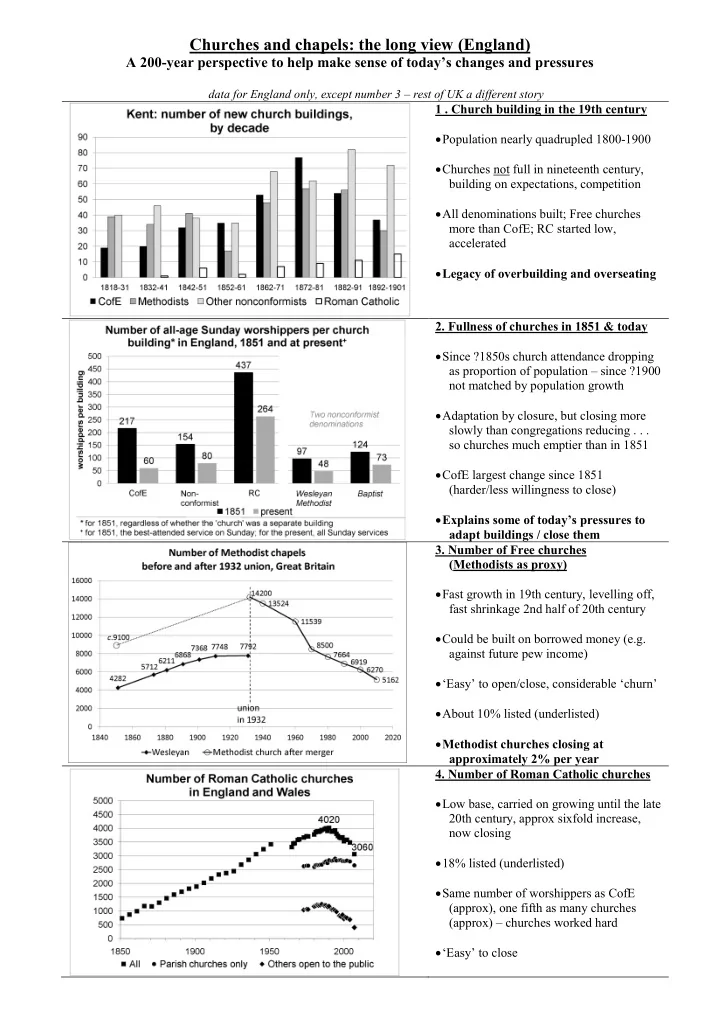

Churches and chapels: the long view (England) A 200- year perspective to help make sense of today’s changes and pressures data for England only, except number 3 – rest of UK a different story 1 . Church building in the 19th century Population nearly quadrupled 1800-1900 Churches not full in nineteenth century, building on expectations, competition All denominations built; Free churches more than CofE; RC started low, accelerated Legacy of overbuilding and overseating 2. Fullness of churches in 1851 & today Since ?1850s church attendance dropping as proportion of population – since ?1900 not matched by population growth Adaptation by closure, but closing more slowly than congregations reducing . . . so churches much emptier than in 1851 CofE largest change since 1851 (harder/less willingness to close) Explains some of today’s pressures to adapt buildings / close them 3. Number of Free churches (Methodists as proxy) Fast growth in 19th century, levelling off, fast shrinkage 2nd half of 20th century Could be built on borrowed money (e.g. against future pew income) ‘ Easy ’ to open/close , considerable ‘churn’ About 10% listed (underlisted) Methodist churches closing at approximately 2% per year 4. Number of Roman Catholic churches Low base, carried on growing until the late 20th century, approx sixfold increase, now closing 18% listed (underlisted) Same number of worshippers as CofE (approx), one fifth as many churches (approx) – churches worked hard ‘ Easy ’ to close
Rate of closure approx 1% per year 5. Church of England churches Steady growth (slower than other denominations), Slow shrinkage of network during 20th century (harder/less willing to close, slower than other denominations’ closure programmes) Closure includes closure of mission chapels Recent rate of closure 30 or fewer per year, now dropping (so less than 2% per decade) Most growth in industrial areas, and up to now most closures too – myth that closures have been rural medieval churches Victorian overpewing (grants, expectations, income) Thinning out of pews during much of 20th century in reaction to overpewing and reduced attendance Current rate of total depewing probably between 2% and 4% of churches per decade CofE still has overcapacity (e.g. twice number of seats needed at Easter) Given the desire to avoid closure, new pressures include downward drift in routine attendance / smallest congregations shortage of stipendiary ministers reduced volunteering shortage of young people (often wrongly described as ‘ageing’) Helpful structural changes include public £ support & support officers non-stipendiary ministry wider use of buildings / base for regeneration tourism Friends groups
FOR REFERENCE Number of listed places of worship (POWs) Larger figures rounded, totals separately rounded All POW Listed POW Total listed by grade of listing ENGLAND I II* II Church of England 16000 12020 4020 4230 3780 Methodist Church 5350 550 3 31 515 Roman Catholic 3230 570 22 100 450 Baptist Union 1950 250 0 11 235 United Reformed 1470 260 0 19 240 Other Christian ? 9000 860 30 120 710 Total Christian POW ? 37000 14500 4070 4510 5930 Non Christian faiths 52 3 15 34 GB & NI England 14500 4070 4510 5930 Wales 1990 170 470 1340 Scotland 2470 370 1570 540 Northern Ireland 900 42 140 710 TOTAL 19850 4650 6680 8520 In England, CofE has approximately 83% of listed places of worship (61% of UK), and most of the highly-listed church buildings in England Other denominations underlisted (increasing appreciation and access) In England, CofE has about 45% of all Grade I listed buildings (religious+secular) Unlike most other listed buildings, many ‘owners’ are volunteers with no personal financial stake in the building Listing brings regulatory burden along with access to limited public funds For sources of most of this material, see Trevor Cooper, ‘How many seats in church?’ in Trevor Cooper and Sarah Brown (eds.), Pews, benches and chairs: church seating in English parish churches from the fourteenth century to the present , 2011. Trevor Cooper 17 January 2012 for APPG for Historic Churches and Chapels cooper@ecclsoc.org
Recommend
More recommend